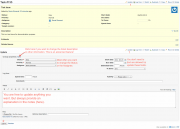Each task for the PPI press team is reflected by a ticket in the PPI Redmine. We use Redmine rather than another tool (Pad or whatever) for several reasons. First of all Redmine's intention is exactly what we use it for: it is a flexible project management web application. There are many advantages using such a system. Every team member can watch tickets, each step is documented and you can even attach files. Tickets can be assigned to other users with automatic notification by eMail on each update.
The web frontend is very easy to use once you know the places of all the features. This guide's intention is to help new team members to get started and old team members to bridge knowledge gaps.
Register
Fill the registration form, wait for the activation link, activate your account by clicking it and let the team leader know that your account is ready. He/She will grant access to the press team project.
Sorting & Filtering
One of the most important features in Redmine is the capability to sort and filter tickets. This feature is located at the Issues page. When accessing this page for the first time the default view is a simple list of all open tickets.
Filtering
Use the "Filters" part for filtering. It is located at the very top (1). The default filter is set to the status "open". To add search criteria choose a filter in the drop down menu on the right (2). A new line with the selected column is added to the filter list. Now you can select a value in the drop down menu. You can add as many filter criteria as you want. To apply the new search criteria click on "Apply" (3).
Sorting
Just click on the column title (#, Tracker, Status, Priority, ...) you'd like to sort by. Clicking the title again changes the sort order.
Advanced fun
The columns can be configured by clicking on "> Options" on the top left (4). You can add or remove columns by selecting them and clicking on an arrow button (5). You can even group tickets by a column. This is configured by choosing a column in the drop down menu "Group results by" (6). Click on "Apply" after the selection is done (3).

Hint: You can save a search (7). If you select the same criteria for the 10th time you probably want to use this feature.
Create a new ticket
This is as easy as pie. Just click on New issue, write a subject, add a good(!) description and click on "create". That's it.

Status updates
One of the most important information besides the current owner and a good ticket description is the current status. A ticket is updated by clicking on "Update" (1) at the top or bottom of a ticket. Please take care in updating the ticket whenever appropriate. Even if the status does not change you should provide additional information when it occurs. This is crucial when a ticket is handed over to another team member. Remember that this may happen at any time since this is voluntary work and we all have jobs and family. It's better to update a ticket too often than too rarely. The target should be, that ach team member can be replaced at any time, and the person filling in knows exactly what is going on and what needs to be done. Click on Submit (2) to save changes to the ticket.
You must update a ticket whenever its status changes.
- New means that the ticket has been created but noone started working on it yet.
- In progress means that the current owner is working on it. He is responsible for this task. If you overtake ownership of a ticket, always ensure that you change it to this status.
- You set the status Feedback if you can't work on the ticket until an information is available or another task is done. This status must be set combined with a clear description on what exactly you are waiting for.
- Resolved means "work done". If this is a press release it also means that the responsible persons according to the processes have authorized the release and the process is completed. Do not set this status unless the job is really done and needs no further tasks apart from distribution!
- You never set a ticket to Closed. This status means archived. This is set by a leader during the next team meeting after a review of all resolved tasks.
- We rarely use the status Rejected. It signifies that the ticket wasn't finished, i.e. because we don't need it anymore.
Please note that you can also update a ticket to add a comment, without changing the status. Always do this if you know of new important facts.
